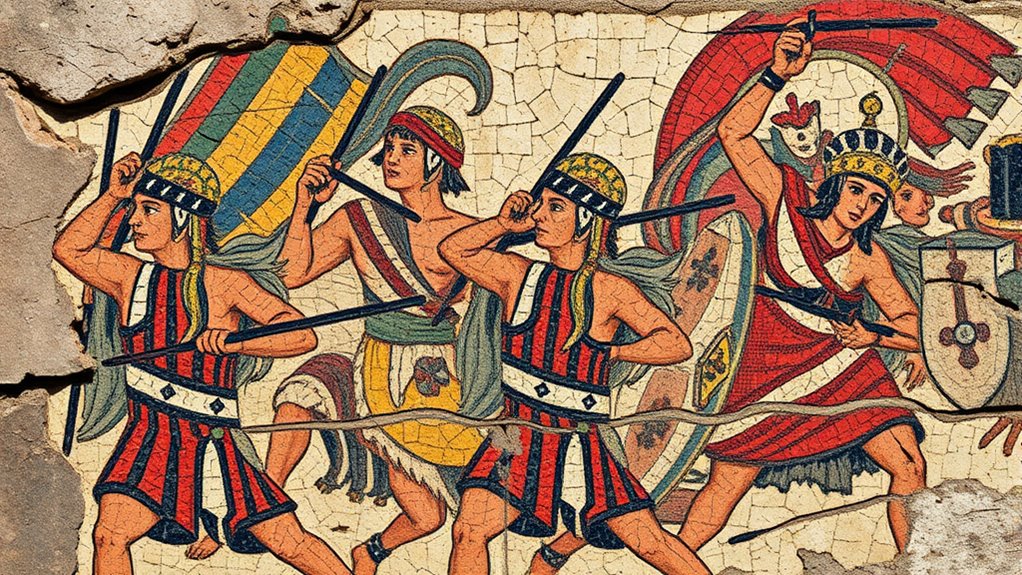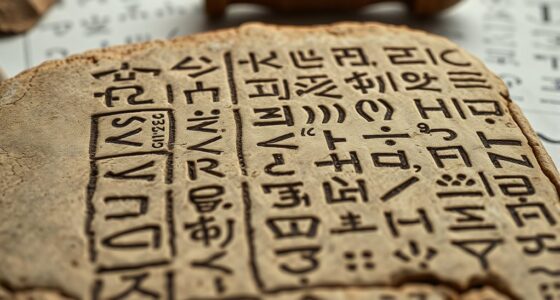Archaeology offers essential clues about Spartacus and his slave revolt, revealing artifacts like weapons, pottery, and military gear that shed light on the conflict’s intensity, strategies, and daily struggles. These relics help us understand the fierce resistance of enslaved fighters and the Roman response. By examining these discoveries, you’ll see how they piece together the brutal battles and resilience of those involved—if you want to explore more, there’s plenty to uncover.
Key Takeaways
- Archaeological artifacts like weapons and relics reveal Spartacus’s guerrilla tactics and the scale of the slave revolt.
- Artifacts provide insight into the daily lives, struggles, and resilience of enslaved fighters during the uprising.
- Roman military equipment uncovered at sites illustrates the technological advantage and strategic organization used to suppress the revolt.
- Battlefield debris and relics help reconstruct the violence, intensity, and brutality of the conflict.
- The collective findings contextualize Spartacus’s movement within Roman military efforts and broader social dynamics.

Have you ever wondered what ancient artifacts reveal about Spartacus and the era he lived in? Archaeology offers a fascinating window into that past, especially when it comes to understanding the Roman military and the context of the slave revolt. While Spartacus himself left no written records, archaeologists have uncovered numerous ancient artifacts that help paint a clearer picture of the tumultuous period. These relics not only shed light on the military strategies employed by the Romans to suppress the revolt but also reveal details about the lives of the enslaved people who fought for their freedom. By examining these clues, you can better grasp the scale of the conflict and the formidable presence of the Roman military in their efforts to maintain control.
Ancient artifacts, such as weaponry, armor, and battlefield debris, are vital in understanding the intensity of the clashes. For example, weapons like swords, daggers, and shield fragments found near ancient sites suggest a fierce resistance by the slaves. These artifacts often bear signs of combat, which tell stories of early guerrilla tactics and the brutal confrontations that defined the uprising. They also serve as tangible evidence of the Roman military’s involvement—Roman legionary equipment found in the region indicates the scale of the Roman response and their technological advantage. Such artifacts help archaeologists piece together how the Roman military organized their campaigns and how they adapted to counter the insurgents. Additionally, the technology used by the Romans, as evidenced by the artifacts, demonstrates their strategic superiority and efficiency in warfare during the period.
In addition to weaponry, pottery, personal items, and remains of temporary encampments reveal insights into the daily lives of those involved. These artifacts indicate the resilience of the rebels, who fashioned makeshift shelters and relied on scavenged supplies during their fight. The presence of Roman military artifacts intermingled with those of the rebels signifies the fierce confrontation and the extent of the Roman effort to crush the revolt. Some discoveries even include inscriptions and graffiti, which offer rare glimpses into the mindset of those involved—whether they were soldiers or slaves—adding emotional depth to the archaeological record.
Frequently Asked Questions
What Tools Did Spartacus Use During the Revolt?
During the revolt, Spartacus used a variety of tools and weapons that reflected typical slave weaponry and revolt strategies. You’d see him wielding swords, daggers, and makeshift weapons like clubs or farm tools repurposed for combat. His tactics often involved surprise attacks and guerrilla warfare, emphasizing mobility and adaptability. These tools and strategies helped him lead a formidable resistance against the Roman forces, showcasing resourcefulness and strategic planning.
Are There Any Remaining Artifacts Directly Linked to Spartacus?
You might wonder if any ancient artifacts or Spartacus relics still exist today. While no definitive artifacts directly linked to Spartacus have been discovered, archaeologists continue to search for ancient artifacts that could shed light on his life and revolt. These relics, if found, would offer invaluable insights into his story. For now, the search remains ongoing, and any discovery would be a significant breakthrough in understanding Spartacus’s legacy.
How Accurate Are the Historical Accounts of Spartacus’ Life?
You’re stepping into a foggy battlefield of myth versus fact when evaluating Spartacus’s life. Historical reliability varies; ancient accounts paint him as both a daring rebel and a hero, but often blur the lines with legend. While some details are rooted in reality, much is shaped by storytelling’s embellishments. So, trust the core events, but recognize that the full picture may shimmer with the glow of myth.
What Was the Daily Life of a Roman Slave Like?
You experience the daily life of a Roman slave through grueling routines and daily hardships. Your slave routines involve hard labor, often from dawn to dusk, with little rest. You face physical exhaustion, limited freedom, and harsh treatment, making every day a struggle for survival. Despite these hardships, some slaves find small moments of camaraderie or fleeting hope, but overall, life is harsh and unforgiving.
Could Spartacus Have Survived After the Final Battle?
You wonder if Spartacus could have survived after the final battle. Myth vs. fact plays a role here, but archaeological evidence suggests he was likely killed during or immediately after the clash. Some stories claim he escaped, yet no strong evidence supports his survival. You should consider that historical records often blend fact and legend, making it hard to confirm his fate definitively.
Conclusion
As you stand amidst ancient ruins, the echoes of Spartacus’s rebellion stir the air. The cracked amphorae and weathered inscriptions whisper stories of defiance, reminding you that history’s shadows still dance beneath the surface. In this silent archaeology, you see more than stones—you see courage etched into time, a symbol of enduring hope. With every relic, you’re drawn deeper into the fierce spirit of those who dared to challenge their chains.









